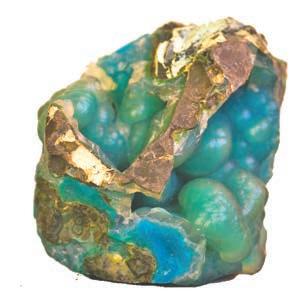
4 minute read
Copper Mining in the Corridor
*Note: Our new series on mining will feature second-generation miners and a column which will address frequently asked questions about mining in general and specifically about the operations in our region. If you have a question you’d like to ask please send it to editor@globemiamitimes.com.
WILBUR BENALLY III Freeport-McMoRan Miami Operations Operator Trainee
Interview by Patti Daley
It’s one of the things he likes about his work as an Operator Trainee at the anode plant in Miami, AZ. There, copper is poured into concrete molds to create slabs 4 ½ ft. in length, weighing 850 lbs. He’s been on the job about 18 months. Wilbur had basic skills and some previous experience in mining, but credits work ethic for landing him the job at Freeport-McMoRan.
Wilbur never thought he would go into mining. His parents both work in offices and that’s what he thought he’d do too, but when he got an office job doing secretarial duties, he found the work didn’t suit him.
The Family Connection
Wilbur’s grandfather, Wilbur Benally Sr., also worked for Freeport-McMoRan. After serving in the U.S. Army, Wilbur Benally Sr. spent his entire career in mining. At Miami operations, he worked in the tankhouse where copper is recovered from a solution as part of the solvent extraction and electrowinning process.
Although Wilbur vaguely recalls a time when miners came home from work dirty, he remembers clearly that his grandfather went to work in collared shirts and nice shoes. He was a supervisor. Now retired, Wilbur Benally Sr. has said little to his grandson about his life in mining.
Forging His Own Path
Wilbur, 22, was born in Mesa and moved to San Carlos in 2006 with his family when his father got a job with the tribe. As a child, he played a lot of sports and dreamed of being in the NFL. After high school, he continued his education with a focus on sports medicine. He got a football scholarship at Bacone College in Oklahoma after playing as a walk-on at Eastern Arizona College (EAC). “Life turns” directed Wilbur away from college and back to work. Mining provided the opportunity he needed.
Wilbur has a wife and young son and works overtime when possible.. He hopes to continue his education one day and is looking into many fields, including business. In his free time, he enjoys the outdoors and spending time with his family.
The Next Generation
When asked if he’d encourage his son to pursue a career in mining, Wilbur is thoughtful.
When asked if he would push him toward football, he also said no.
FAQ ON MINING OPERATIONS IN GLOBE-MIAMI Mineral Display features the regions array of precious gems & minerals

By GMT Staff
Although the area is best known for its copper mines, the region produces an array of gems and minerals. “Arizona is amazing,” says Tom Foster, executive director of bullion Plaza in Miami. “Arizona is just this great repository of pretty much anything you can ever think of in the way of minerals. Not only stuff that is marketable,like copper, gold and silver.”
Statewide, but particularly in Gila County, many of the gems and minerals in the area are quite literally brought to the surface by copper mining. As Wolfgang Mueller, curator of gems for Bullion Plaza, writes in a 2012 issue of Rocks & Minerals, “The geological processes responsible for the copper ore deposits have set much of the stage for the grand collection of gemstones found here.” Among the “grand collection” are azurite, malachite, chrysocolla, gem chrysocolla, turquoise, jasper, quartz, tourmaline, bohmeite, amethyst, apache tears, argillite, and jasper.
Gems include chrysocolla, turquoise, amethyst, azurite, and tourmaline.
A beautiful collection was recently donated to Bullion Plaza Museum by Les & Paula Presmyk, with the help from the museum’s mineral curator, Wolfgang Mueller and his wife Diane. It is now part of the permanent displays found in the new Mineral Hallway.
“We are excited about this new addition, and anxious to be able to share it with the public, when the COVID-19 goes down to the point where we can re-open,” says Foster, who continues work behind the scenes to enhance the museum’s displays.

JOB POSTINGS
Discover job Discover job opportunities with opportunities with our local mines






